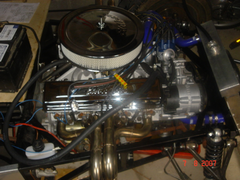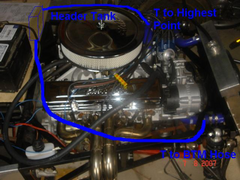
Rover V8 - Cooling/Plumbing Help
wjggregg - 7/8/07 at 09:28 AM
Hi All, I wonder can anyone offer me any advice on the best way to effectively cool my V8. Heres my setup...
3.5L RV with Bespoke Ali Radiator. The rad has usual top and bottom outlets and an overflow in the neck. The Rad is NOT at the highest point in the
system. If you see from attached photo, the top hose is at the highest point.
If I was to simply add an inline filler to the top hose and change the rad cap(and block the overflow), would this work??? Or should I fit a Header or
Expansion Tank? If so, what is the best way to plumb it into my current setup?


Rescued attachment DSC04237.JPG
v8kid - 7/8/07 at 11:28 AM
Yup you need a header tank with a 25mm filling pipe and a 8/10mm pipe from the highest point to the top of the header tank to continually bleed off
air bubbles. Make sure when you install it that the pressure in the bleed pipe is higher than the pressure in the filling pipe or you will suck in the
air from the header tank rather than bleed air into it. Goes without saying the header tank has to be the highest point
craig1410 - 7/8/07 at 12:13 PM
I have the following setup which seems to work for me:
Radiator mounted like yours such that it is not the highest point. My radiator doesn't have a cap by the way, just a bleed pipe (8mm).
Heater pipes looped above bellhousing to allow constant flow around block and inlet manifold when thermostat closed.
Rover SD1 expansion tank fitted with 8mm pipe linking top of radiator with inlet manifold (SU type) bleed pipe (highest point) and then on to
expansion tank.
I do have a problem with my top hose trapping air and intend to fit a bleed pipe but this will only be a screw valve to allow manual bleeding of the
pipe after filling (at the moment I just squeeze the air out). My top hose and radiator get hot so flow doesn't seem to be a problem.
The expansion tank works just fine even though it is mounted on my scuttle (ie. not the highest point). It only has an 8mm connection at the bottom so
air bubbles can be expelled no problem. When hot it expands close to the top of the tank and when it cools it drops back to the "coolant
level" mark.
Obviously you do need an expansion tank of some sort or you will lose water through your pressure cap all the time. My solution isn't perfect by
any means but it seems to get the job done.
Many people recommend drilling 3x3mm holes in the thermostat to reduce the chance of air locks.
Cheers,
Craig.
wjggregg - 7/8/07 at 12:35 PM
Thanks for the feedback....... Is this the idea????
If so, do I change the rad cap to a valveless one and block off the Rad overflow?


Rescued attachment Header Tank.JPG
